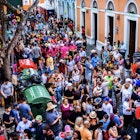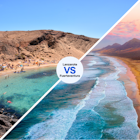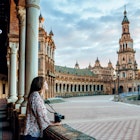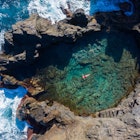Ross Clarke recently returned from Fuerteventura where he was researching for the upcoming Canary Islands guidebook (publishing November 2024). This is his ultimate guide to planning your holiday to Fuerteventura.
When people think of the Canary Islands, sunshine and seaside fun usually spring to mind. And rightly so, as the archipelago is awash with both pristine, white sands and dark, volcanic shorelines. But ask any local and they’ll confirm that Fuerteventura is the go-to island for beaches, thanks to the miles of golden sands dotted around its coast.
Fuerteventura goes a little under the radar compared to its popular neighbors, Tenerife, Lanzarote and Gran Canaria, and the island moves at a much more laid-back pace. But don’t let that easygoing charm fool you into thinking there's no excitement to be had. After all, this is one of the best places in the world for outdoor adventures such as windsurfing, hiking and stargazing.
It's the second-largest island in the archipelago, the oldest and the most arid of the bunch, with soft, undulating volcanic mountains worn of their harsh peaks by millennia of erosion. It’s also a desert interspersed with lush green oases packed full of history and charm, from intriguing remains of its pre-Hispanic inhabitants, and vestiges of the European colonizers, to mind-blowing geological formations.
When should I go to Fuerteventura?
Fuerteventura enjoys year-round balmy temperatures and is hugely popular for those seeking winter sun. It means that its main resorts – Corralejo to the north and Jandía to the south – are particularly busy between November and February when the weather is usually a pleasantly warm 20°C (68°F) with long sunny days. That said, the island has a busy summer season too, when temperatures can reach 30°C (86°F).
For those looking to get the most out of both the coast and the central peaks, as well as anyone visiting on a budget, consider coming in what’s known as shoulder season in spring and autumn. You’ll find that the temperatures allow for hiking and sightseeing without the oppressive heat of summer, but are pleasant enough to enjoy time on the glorious sands and in the bracing Atlantic Ocean.
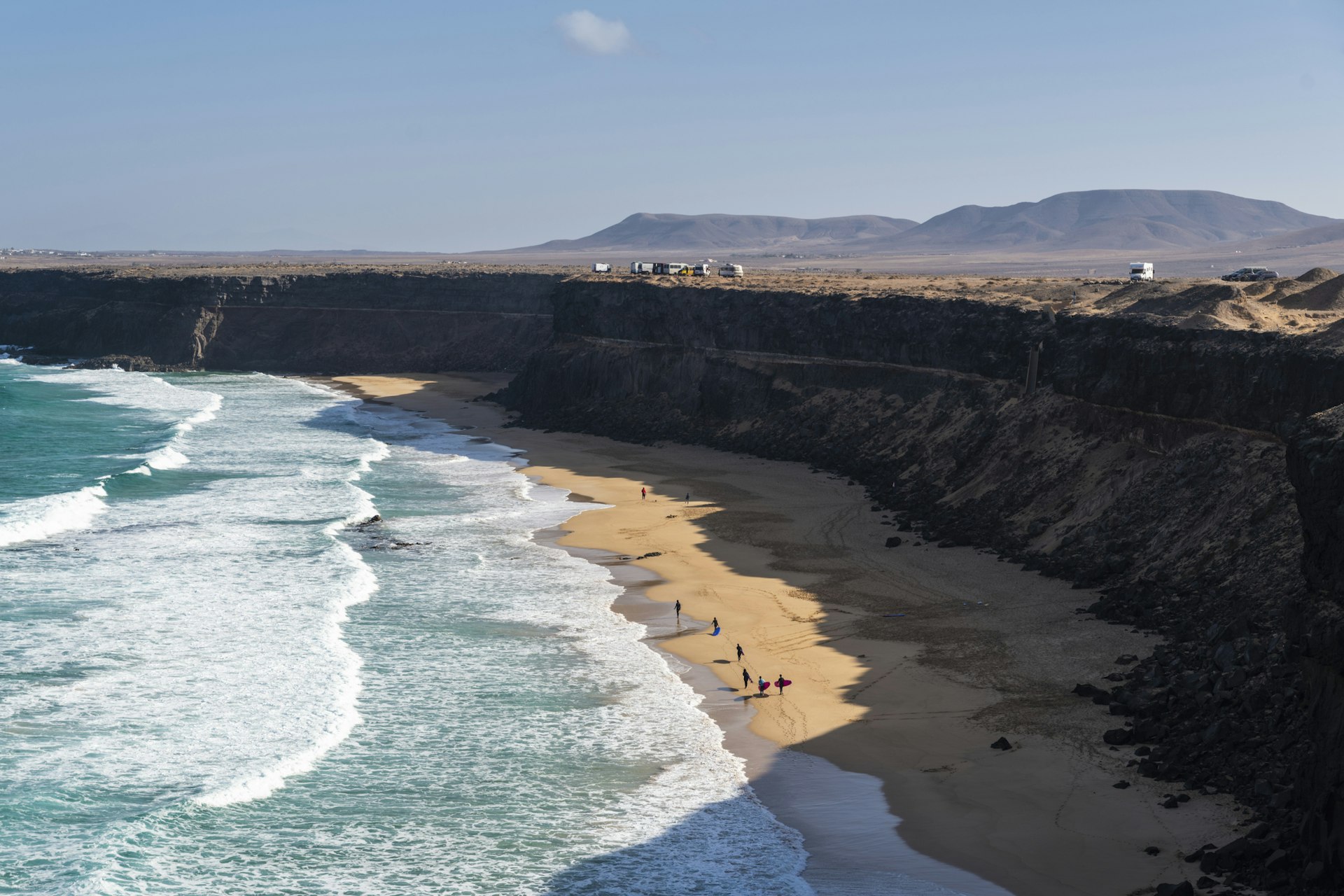
How much time should I spend in Fuerteventura?
Most people visiting Fuerteventura come for a week or two, which gives you time for both relaxing on the beach and exploring the island. If you’ve only got a week to spare, consider hiring a car and splitting your time between either the busy north coast and center or the busy south coast and center.
The northern coast is packed with beaches popular with surfers trying to catch the best swells, from El Cotillo on the west coast to Corralejo on the east. Talking of Corralejo, this is also where you’ll find the majestic sand dunes of the natural park. The town is also home to both charming fish restaurants and exuberant nightlife, ideal for all types of travelers including families.
Similar scenes are to be found on the Jandía peninsula, but instead of surfers you’ll find windsurfers, and in place of dunes, you’ll be able to walk along miles of flat sandy beach. There are also resorts offering plenty of accommodation options.
The central part of the island is a mix of mystical mountains dotted with pretty towns and villages, many of which serve great local Canarian cuisine, and scorched desert-like tundra and volcanoes you can climb to see the giant craters.
If you’re only here for a day or two – perhaps jumping off a cruise ship or making the 30-minute ferry trip from Lanzarote – then there’s still plenty you can pack in. Contemplate digging into the island's traditional industries such as salt harvesting, cheese making and aloe vera products. There are museums and workshops not far from the capital of Puerto del Rosario. If you are in the city, check out its art trail where you’ll see sculptures and outdoor artworks along the promenade and winding streets.
Is it easy to get in and around Fuerteventura?
The island has one airport for both international and domestic flights, conveniently located in the center. Book a window seat to enjoy views of the colorful landscape and neighboring islands. Once safely on terra firma, the best way to get around is by car and rentals are relatively cheap. Consider hiring from a local provider such as CICAR.
The main motorway runs the length of the island on the flatter east coast making it easy to get around. Most other roads are well maintained, although some sights are on well-compacted dirt tracks – make sure your car insurance covers off-road driving.
Once in the main resorts, you can easily walk or hire bikes to get around. Buses are frequent and inexpensive and run to all parts of the island. They are operated by Tiadhe and you pay the fare directly to the driver when boarding. Ferries run from Corralejo to Playa Blanca in Lanzarote and from both Morro Jable and Puerto del Rosario to Las Palmas de Gran Canaria.
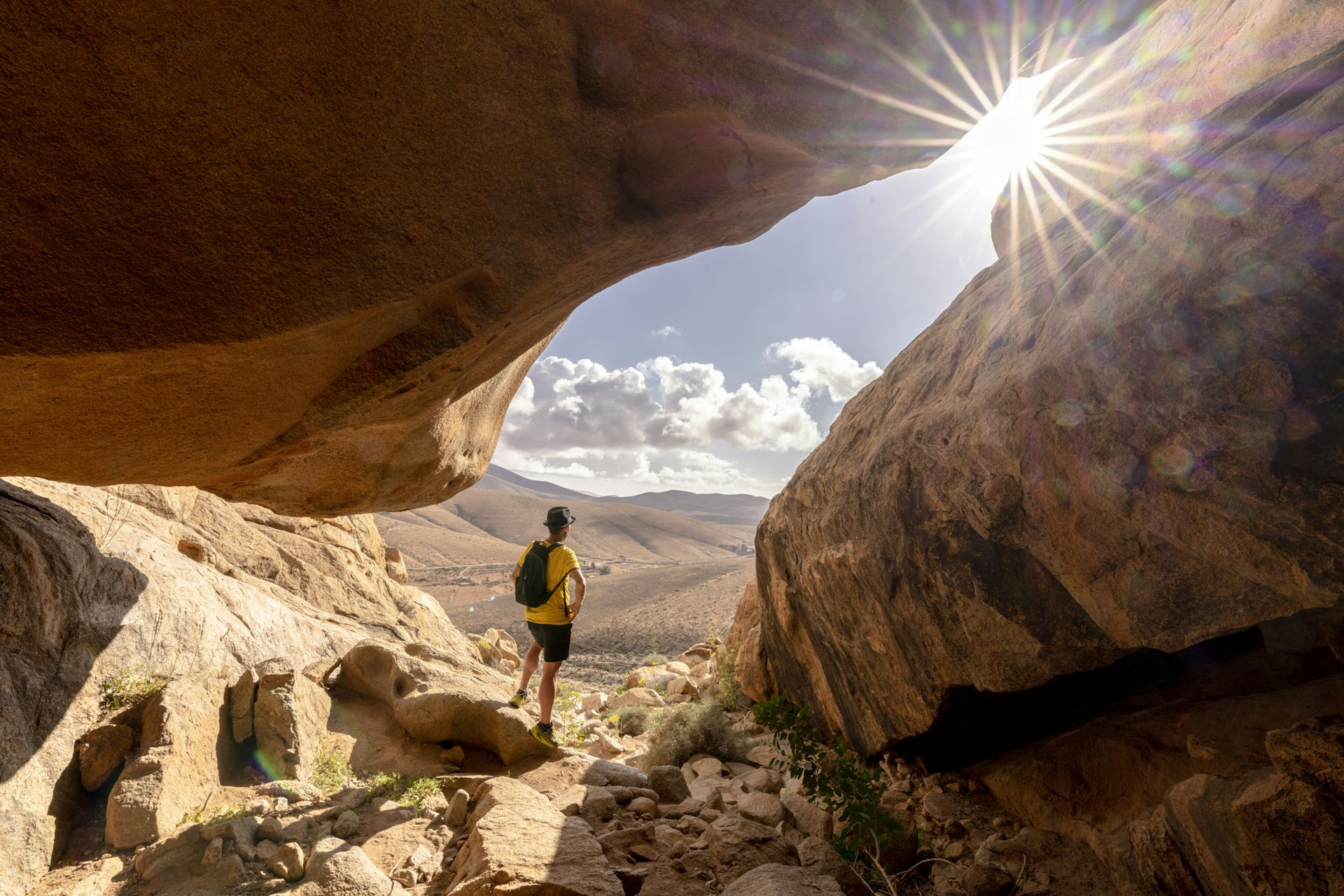
Top things to do in Fuerteventura
Take to the water
You can’t visit Fuerteventura without making the most of the sea. Surfing is just one of many water-based pursuits along with stand-up paddle boarding, diving, kayaking, windsurfing and more. There are surf schools for all levels and ages, but the laid-back folks at Surfintrip in Corralejo are experts in these waters. They'll take you – beginner or pro – to the best spot on the north coast that day, give you clear and safe instructions, provide all the kit, and make sure you have plenty of time in the water to test your skills. They also do residentials where you can stay in their villa and take daily classes.
Join in at the farm
Goats have been reared on the island for centuries and farmers have been making cheese with their milk for just as long. Majorero cheese (cheese from the Majorero goats of Fuerteventura) has protected status from the EU for its quality and sense of place. As well as being on the menu boards of most cafes, bars and restaurants, you can visit many farms and dairies where they make and sell this delicious delicacy.
Even better, why not try your hand at making it yourself? La Casa del Queso Cabrera Perez offers visitors the ability to milk and feed goats, make cheese, package it up, and most importantly taste it in a wonderfully interactive workshop, all run by the family. Contact them directly to book your spot.
Make a beeline to the beach
This might sound obvious, but beaches are Fuerteventura’s main draw for visitors with good reason. There are loads to choose from, yet none more beguiling and breathtaking than Cofete on the Jandía peninsula. You can only reach this secluded beach by bus or car over an extremely bumpy dirt road, but the reward is an unblemished 13 kilometers of golden sand backed by imposing mountains. It’s been the filming location for many blockbusters, including Star Wars, thanks to its otherworldly nature.
Step back in time
If you only go to one place in the center of the island, make it Betancuria. This tiny town tucked up in the mountains is where Spanish colonizers decided to build their capital in 1404, led by Jean de Bethencourt (whom the town is named after). It has been well preserved and an easy-to-follow trail around the streets tells you about the history.
The restaurants here are particularly good, with Casa Santa Maria serving classic dishes (especially renowned for baifo – roasted kid goat), and La Sombra offering burgers, vegan and veggie options on its shady terraces. Don’t miss the Museo Arqueológico de Fuerteventura to learn all about the island’s pre-Hispanic inhabitants.
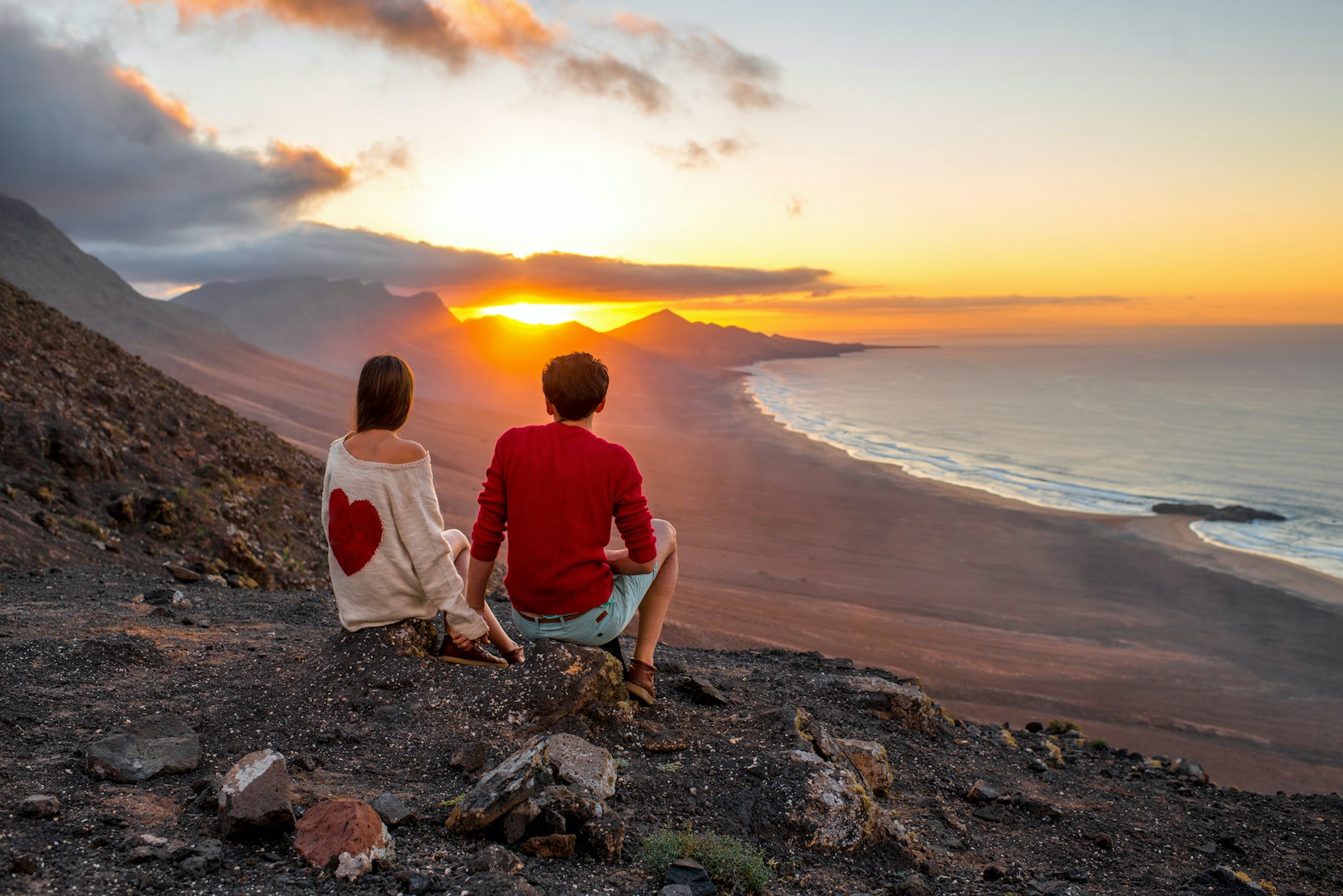
My favorite thing to do in Fuerteventura
There’s something about the light in Fuerteventura that's different from the other islands, and I will never tire of it. Perhaps it’s the landscape or the way the sunlight throws light and shade onto the ochre soil, I’m not quite sure, but it is just spectacular
One of my favorite things to do is catch the sunset at one of three points on the island. The first is at the crossroads on the road to Morro Jable and Cofete. This point gives you the most magnificent view over the low-lying southwest towards the horizon of the wild Atlantic.
The second is driving the winding FV-605 road from the south up to the Mirador Astronómico de Sicasumbre. You’ll witness the changing colors of the pillow-like mountains from brown to orange to pink, as you twist and turn higher before reaching the stargazing spot to witness the night sky illuminating the landscape.
The final spot is in the middle of the Corralejo Dunes Natural Park. Take the FV-104 from Corralejo and find a spot on the side of the road. Pack a picnic and watch the sun set behind the dunes and mountains as the sky becomes an orange and purple kaleidoscope.
How much money do I need for Fuerteventura?
Fuerteventura can be extremely reasonable especially out of season and away from touristic areas. While nearly everywhere accepts credit and debit cards, it’s worth having a few Euros on you for incidentals and more rural areas.
- Hotel room: €50-€150 per night
- Six-bed villa: €300-€500 per night
- Bus tickets: €1.50
- Coffee: €1.50
- Tapas meal for two: €30-€50
- Beer/glass of wine: €3
- Sunbed rental: €5-€10 per day
- Surf lesson: €55-€75 for half a day
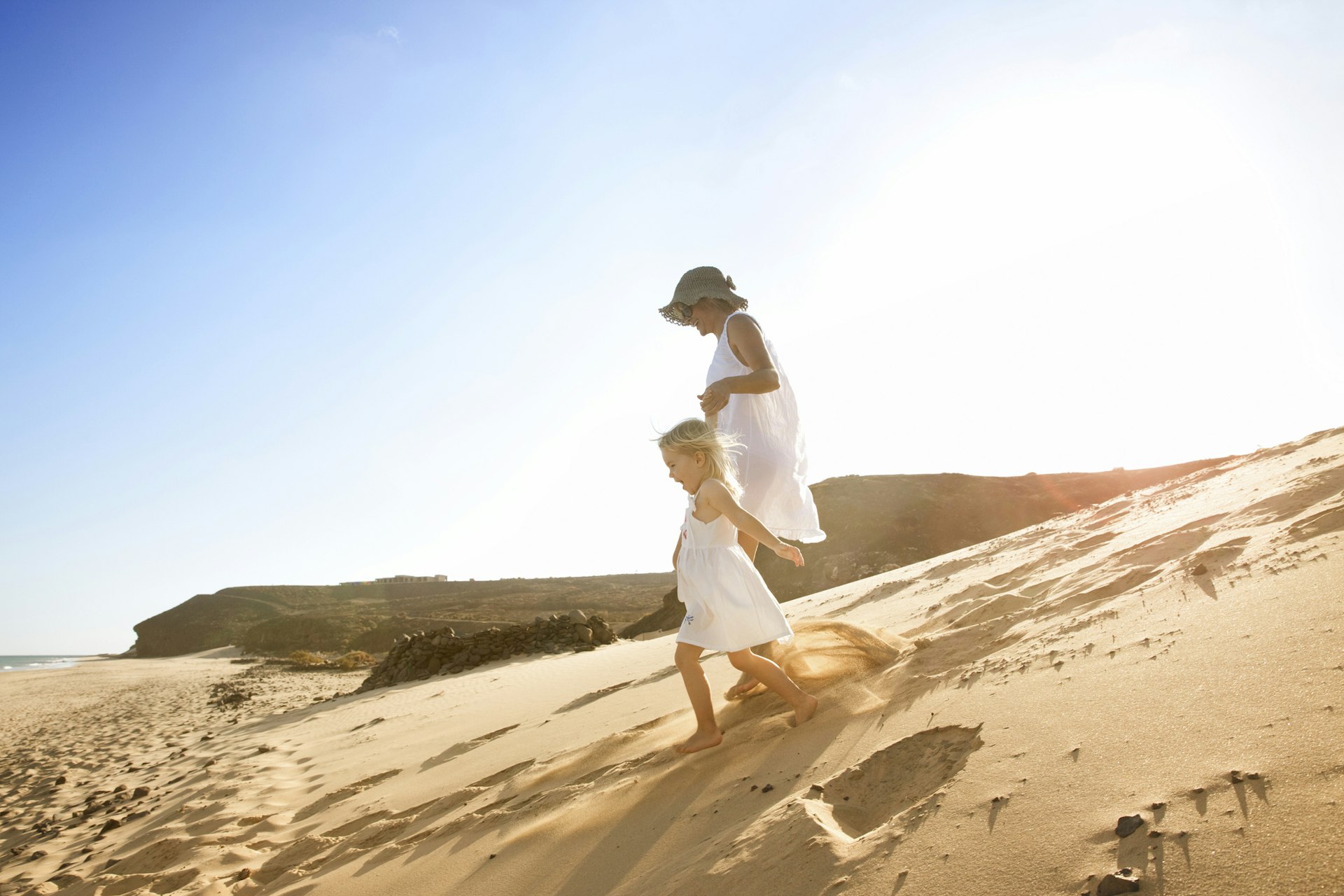
Stay hydrated in the sun
Water is an incredibly scarce resource on the island – it only gets a handful of rainy days a year – so be mindful not to waste any. It’s also better to buy bottled water from a supermarket than drink tap water as while it is potable, the high mineral content can cause an upset stomach. Always carry water with you as temperatures can soar, especially at midday, and it’s easy to get dehydrated.
Check the tides
While the sea is one of the best parts of Fuerteventura, it’s always advisable to check the currents. Some areas, particularly in the south, have strong currents and swimming is extremely dangerous. Stick to the beaches with lifeguards and as a general rule of thumb, do as the locals do.





